APALIGHT: Biomimetic SPF mineral booster for sustainable sunscreen
TRENDING TECHNOLOGIES
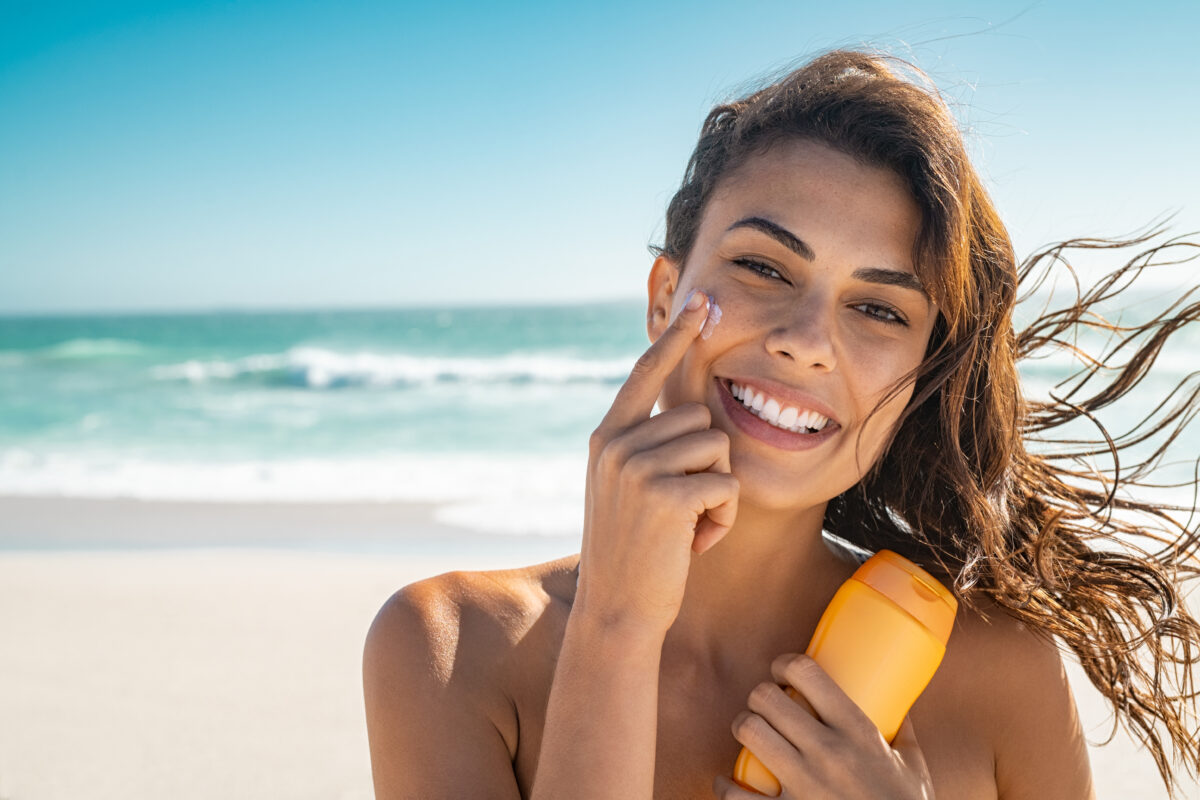
29 September 2022
Sunscreens are well known to prevent damage related to environmental stress, including UV-A and UV-B rays. Chronic and prolonged exposure to sunlight causes damaging effects: UV-B are responsible for erythema and sunburn, while UV-A causes photo-ageing, acute and chronic photodermatosis and immunosuppression.
UV filters are molecules or molecular complexes that absorb, reflect, or disperse radiation and they represent the main protection measures against UV. They are divided into two main types: organic (chemical) and inorganic (physical) filters, due to their molecular nature and mechanism of action. Chemical filters absorb radiations while physical filters are mineral particles that reflect and diffuse them.
Sun filter concerns
Some organic filters, when affected by radiation, could potentially produce dangerous chemical compounds known to be allergenic and to
cross the skin barrier due to their molecular weight and lipophilic character; additional studies prove their photo-instability that may cause damage induced by ROS formation. Moreover, their potential estrogenic effects are very controversial. Therefore, organic filters are expected to induce more toxicity than inorganics.
Besides safety concerns, some organic UV filters contribute to contamination of the environment, specifically through their bio-accumulation in seawater with repercussions for aquatic ecosystems. The various methods of removing UV filters from the water are poorly effective and the best ones are very expensive. Mineral filters report low environment risk being mineral substances, they are preferred for their sea eco-system aspect.
In order to find an appropriate compromise between safety and functional parameters, the industry has addressed growing attention to sunscreen containing only inorganic mineral filters or based on a hybrid use of inorganic and organic filters with the target of reducing the overall amount of filters content in the formulation and take advantage of their synergistic UV screening features to increase SPF.
This article explains how a SPF mineral booster based on biomimetic hydroxyapatite (Apalight, by Kalichem; INCI name:hydroxyapatite) used in sun care formulation, acting with a mechanism comparable to inorganic filters like zinc oxide and titanium dioxide, offers proven benefits in terms of multifunctionality, texture improvement, safety and low environmental impact.
Biomimetic HAP: Biocompatibility
Hydroxyapatite (HAP) is a mineral occurring in nature based on calcium, phosphate and hydroxyls, with the following stoichiometric composition: Ca10(PO4)6OH2.
Hydroxyapatite forms also physiologically occur in human tooth and bone: in contrast to stoichiometric HAP, the bone and tooth mineral is structurally disordered, and compositionally nonstoichiometric due to the presence of a substantial amount of anionic (e.g., HPO42−, CO32− ,Cl−) and cationic (e.g., Na+, Mg2+) species, together with the presence of ion vacancies into the crystal lattice.16 Such variants fall in the ‘physiological HAP’ category.
Physiological HAP is the main mineral of dental enamel and dentin; 70% of human bone is made of it. Fishbone is also mainly composed of HAP. In light of its physiological nature, physiological HAP can be synthetized to obtain the ‘biomimetic HAP’ mineral. Such a mineral has multiple applications as biocompatible material: it is used as coating to promote bone ingrowth into prosthetic implants, in aesthetic medicine to fill wrinkles and homogenize skin texture, while in oral care it is used to promote tooth remineralization, anti- plaque and anti-caries activities.
It is also considered to be an anti-ageing active since it is a source of calcium and phosphate ions for epidermal cells and its mineral surface has been proven to subtract sebum unsaturated fatty acids otherwise exposed to UV rays and converted in lipid peroxides. Furthermore, it can also be used as a pharmaceutical carrier.
SPF Booster with light texture & no white effect
Apalight biomimetic hydroxyapatite is a natural-like mineral with porous and rough surface, with ‘acidic pH-dependent’ solubility. Its mineral nature and specific refraction index (n=1.6) make it ideal as booster in sunscreen application as replacement of inorganic filters in hybrid formulations containing organic filters, it can also be combined to inorganic filters in mineral sunscreens.
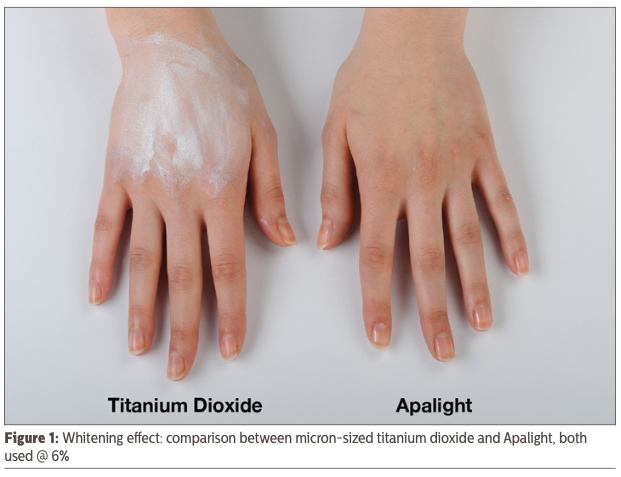
Given its little bit lower refraction index than titanium dioxide and zinc oxide, its presence in formula enables to keep an effective screening action against UV-rays, while avoiding the typical blue whitening effect and heavy texture associated to the previously mentioned inorganic filters (Figure 1).
Furthermore, the physiological presence of hydroxyapatite in the fishbone composition is a key element to consider in the evaluation of the use of synthetic biomimetic hydroxyapatite for sunscreen products, especially in the optics of development of sunscreens containing ingredients similar to components expressed in the sea eco-system. In addition to its sustainable nature, biomimetic hydroxyapatite use is approved in natural eco-certified cosmetics and its powdery form boasts values of 100% naturalness, with a natural index score of 1.
Photostable SPF and UV-A protection booster
In accordance to the ISO24443:2012 standard, the UV absorbance curve and the critical wavelength of a cosmetics formulation containing 22% of biomimetic hydroxyapatite was assessed in absence of registered sunscreen filters and SPF/UV-A protection booster to evaluate the contribution of HAP itself in terms of UV absorbance.
The test enables to identify the absorbance curves of a thin film of product spread over a rough substrate, before and after exposure to a controlled dose of UV radiation from a solar simulator and determine the photo-stability. The resulting spectral absorbance provides a representation of both the width and the height of its UV-protection characteristics.
According to the above-mentioned methodology, the biomimetic HAP-based formulation showed overlapping absorbance spectra before and after irradiation, with a critical wavelength of 384 nm. The results suggest therefore that HAP shows maximum photo-stability after exposure to UV radiation (Figure 2).
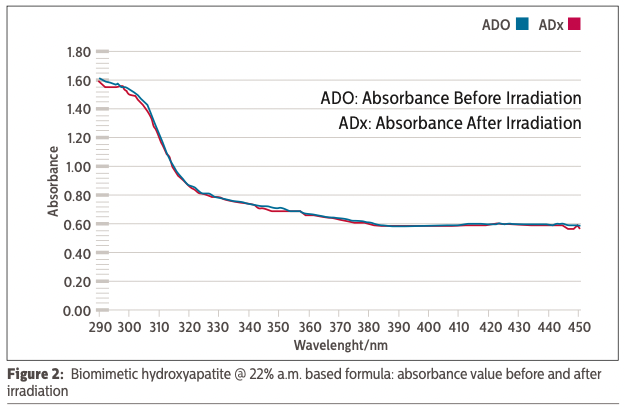
SPF mineral sunscreen
A base formulation containing biomimetic HAP active matter at 25% and zinc oxide at 4%, developed in cold process and using exclusively eco-certified raw materials (Table 1) was tested through a preliminary SPF in vivo test carried out on three subjects (phototype II and III, average skin tone ITA° 68), according to the Protocol of COLIPA International Sun Protection Factor Test Method, May 2006.
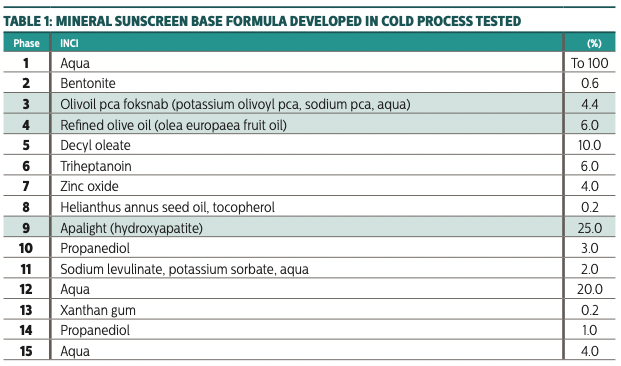
The same formulation was tested in vitro following the ISO24444:2012 standard to assess UV-A PF. The results reported in Figure 3 show average SPF protection value of 33.4 and UV-A protection factor of 13. The UV-A/UV-B protection ratio observed of 0.39 complies with the 1/3 value required to achieve the broad- spectrum label claim.
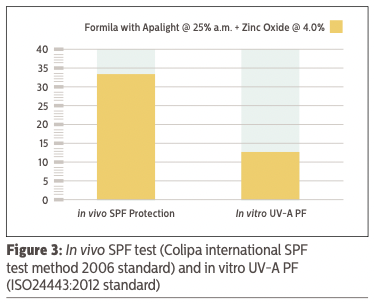
SPF hybrid sunscreen
Hybrid sunscreen formulations containing blends of mineral and organic filters were taken into evaluation to assess the contribution of biomimetic HAP to increase organic filters in vivo SPF and compare it to the SPF increase induced by titanium dioxide. In vitro UV-A protection factor was also assessed. In detail, two formulations were analyzed, with the composition details and final results summarised in Table 2.
Formula 1
The organic filters blend SPF value reported corresponds to 30. By adding to such system 4% of titanium dioxide or 4% of biomimetic HAP,
the final SPF recorded of the formulations was 34 after the addition of titanium dioxide and 40 after the addition of HAP. The UV-A/UV-B ratio (data not shown in table) was kept in both cases, with values of 0.5 for titanium dioxide-based formula and 0.35 for HAP-based formulation.
Formula 2
The organic filters blend SPF value reported corresponds to 50. By adding to such system 5% of titanium dioxide or 5% of biomimetic HAP,
the final SPF recorded of the formulations was 64 after the addition of titanium dioxide and 65 after the addition of HAP. The UV-A/UV-B ratio (data not shown in table) was kept in both cases, with values of 0.38 for titanium dioxide-based formula and 0.33 for the HAP-based formulation.
The results suggest therefore that the +1:1 replacement of titanium dioxide with HAP to organic filters based formulations is expected to keep comparable SPF increase values, while optimizing texture, reducing the formulation whitening and maintaining the UVA/UVB ratio.
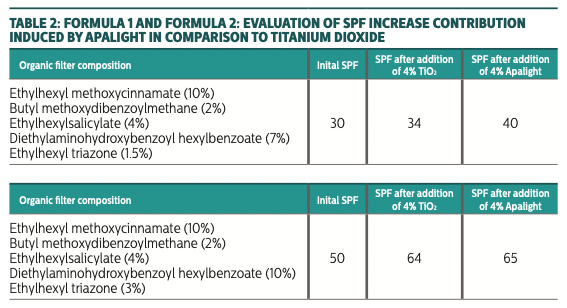
Multifunctional SPF booster
Biomimetic HAP differentiates from other minerals frequently used in sun care for its in vivo solubility, triggered by the skin acidic pH and its peculiar external porous surface able to create many anchor points with external substrates. In such a context, HAP time- controlled and partial ions release is suggested to promote several skin benefits, especially following long-term application, given by increased signalling of key ions like calcium and phosphates.
Biomimetic HAP was tested at 6% active matter in emulsion against a placebo cream in order to assess the following parameters: elasticity, firmness – by analyzing the R2 and R6 parameters through a Cutometer SEM 575 made by Courage & Khazaka of Germany – and roughness (through skin surface replicas and image analysis), in order to quantitatively determine its additional benefits. Ten female volunteers (age range: 40 to 70) were included in the study, applying the product twice a day on the entire face for four weeks.
Antiageing action
The treatment with biomimetic HAP highlighted an increase of the skin elasticity (R2) parameter by 10.3% (Figure 6), and a decrease of visco-elasticity by 17.1%, (value R6). The visco-elasticity is a key parameter to assess skin stretchability, whose value is inversely proportional to skin firmness increase (reduction of skin stretchability corresponds to higher skin keratinocytes compactness, hence increased firmness). Elasticity and firmness are key aspects to consider in sun care products, keeping in mind that prolonged sun exposure dries out the skin.
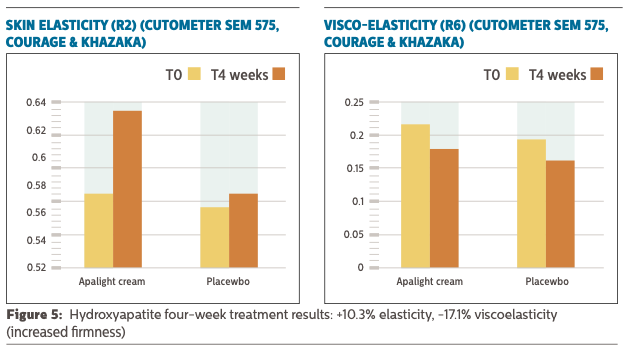
Anti-wrinkle
In order to evaluate the anti-wrinkle action, skin replicas were used: in detail a fast-hardening synthetic polymer (SILFLO by Flexico, UK) and adhesive disc were chosen with the aim of having an identical imprinting on the skin. To analyze the results, according to the Corcuff method, some images were taken through a processing software (Quantilines, Monaderm, Monaco).
The silicone replica of the skin surface was illuminated by a light source with an incidental angle of 35°. The images (covering 12×9 mm of each skin replica) were acquired through a video camera (high performance CCD camera, COHU, Monaco). This instrument enables to analyze the following parameters: Ra (roughness value), Rz (maximum roughness value, namely deep wrinkles).
The anti-wrinkle efficacy is given by a decrease of Ra and/or Rz values. The treatment with biomimetic HAP (Figure 6) showed statistically significant deep wrinkle reduction (Rz) compared to the placebo treatment by around 10%.
The results achieved by the biomimetic hydroxyapatite in the previously mentioned tests confirm its suitability for inclusion in multi- functional sunscreens as well as in products for skin protection and anti-ageing claiming SPF.
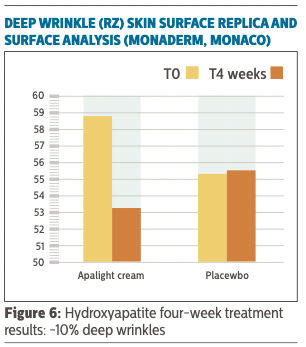
Conclusion
Sunscreens market has experienced a consistent increase of interest toward the use of mineral filters and boosters as well as ingredients with multifunctional features, high naturalness, sustainably sourced and with low environmental impact.
Apalight biomimetic HAP is a specialty ingredient based on a mineral comparable to that occurring in the human body and in the sea ecosystem. This specific type of mineral is traditionally used in medical applications (as coating to promote bone ingrowth into prosthetic implants, and as a rejuvenating solution in aesthetic medicine etc.). It represents an interesting innovation for sun care, as it enables the formulation of fully natural mineral sunscreens with optimized sensorial features and hybrid sunscreens in combination with organic filters to achieve high SPF protection values.
HAP mineral does not give any applicative whitening effect and shows a light texture that drastically differentiates it from micron sized inorganic filters, enabling to either reduce their amount in mineral sunscreens or totally replace them in hybrid sunscreens. Furthermore, its biomimetic nature, its peculiar external surface and pH dependent oligo-elements release triggered by skin acidic values promote multiple benefits, including elasticity enhance, maintenance of skin barrier integrity and anti-wrinkle features.
In the wake of the studies previously shown, biomimetic HAP represents therefore a promising candidate for the development of heterogeneous multifunctional sun care products in the name of environmental sustainability.
Ingredients
Formulations
SPF 50+ Sunscreen Lotion
Light sunscreen, with no whitening effect, formulated with an innovative Cosmos approved mineral booster (APALIGHT), internationally patented. Sprayable formulation.
Advanced Mineral SPF 30 Cream – Cold Process
Mineral sunscreen developed in cold process. Based on Cosmos approved Olivoil PCA as emulsifier and Apalight as SPF mineral booster
Sunscreen Spray SPF 18
Light sunscreen, with no whitening effect, formulated with an innovative Cosmos approved mineral booster (APALIGHT), internationally patented. Sprayable formulation.
Anti-Wrinkle Serum
Serum based on Sodium DNA (KALINAT AW POWDER), based on polydeoxyribonucleotides with anti-wrinkle, elasticity enhancing and regenerative action.











